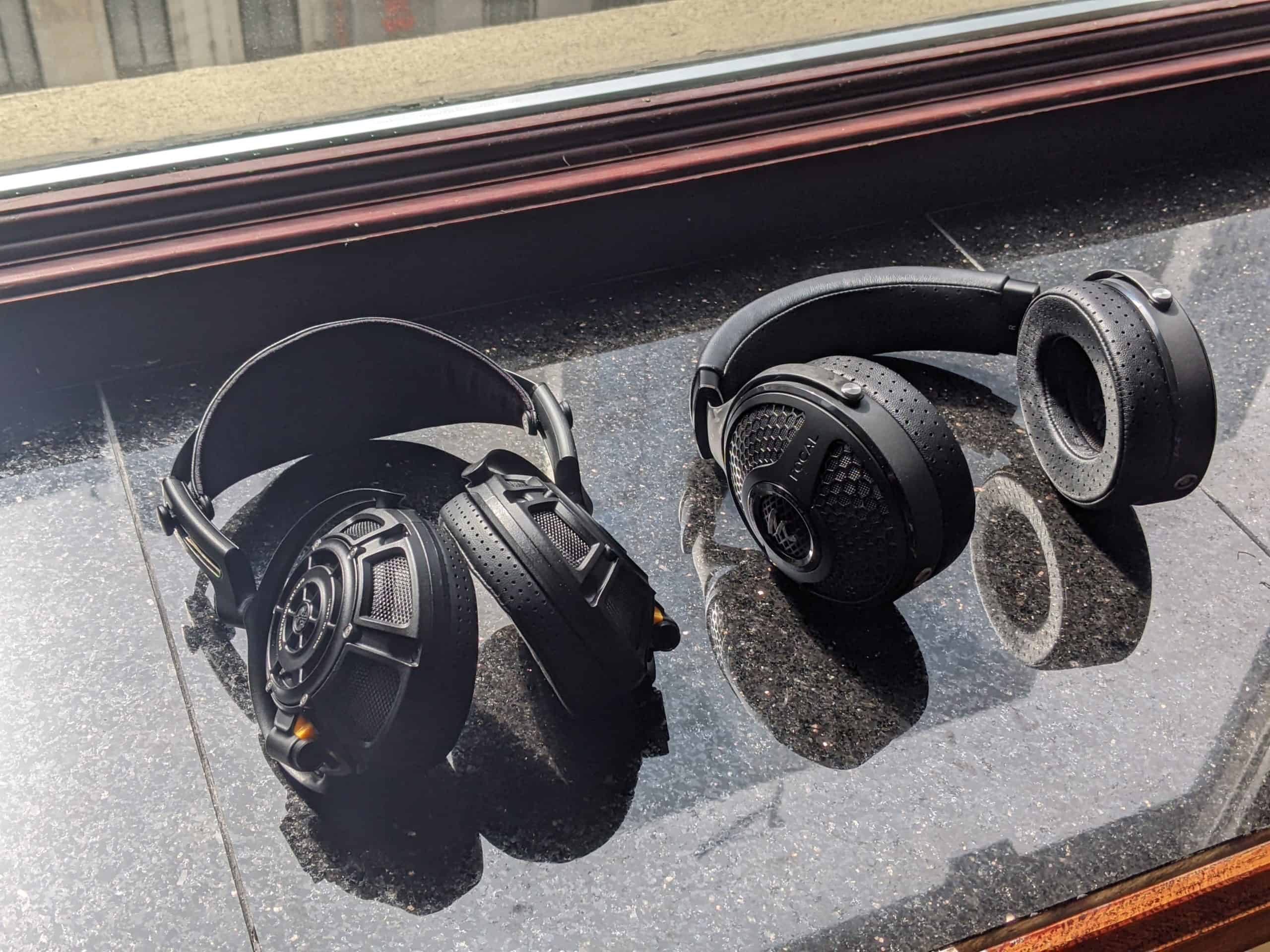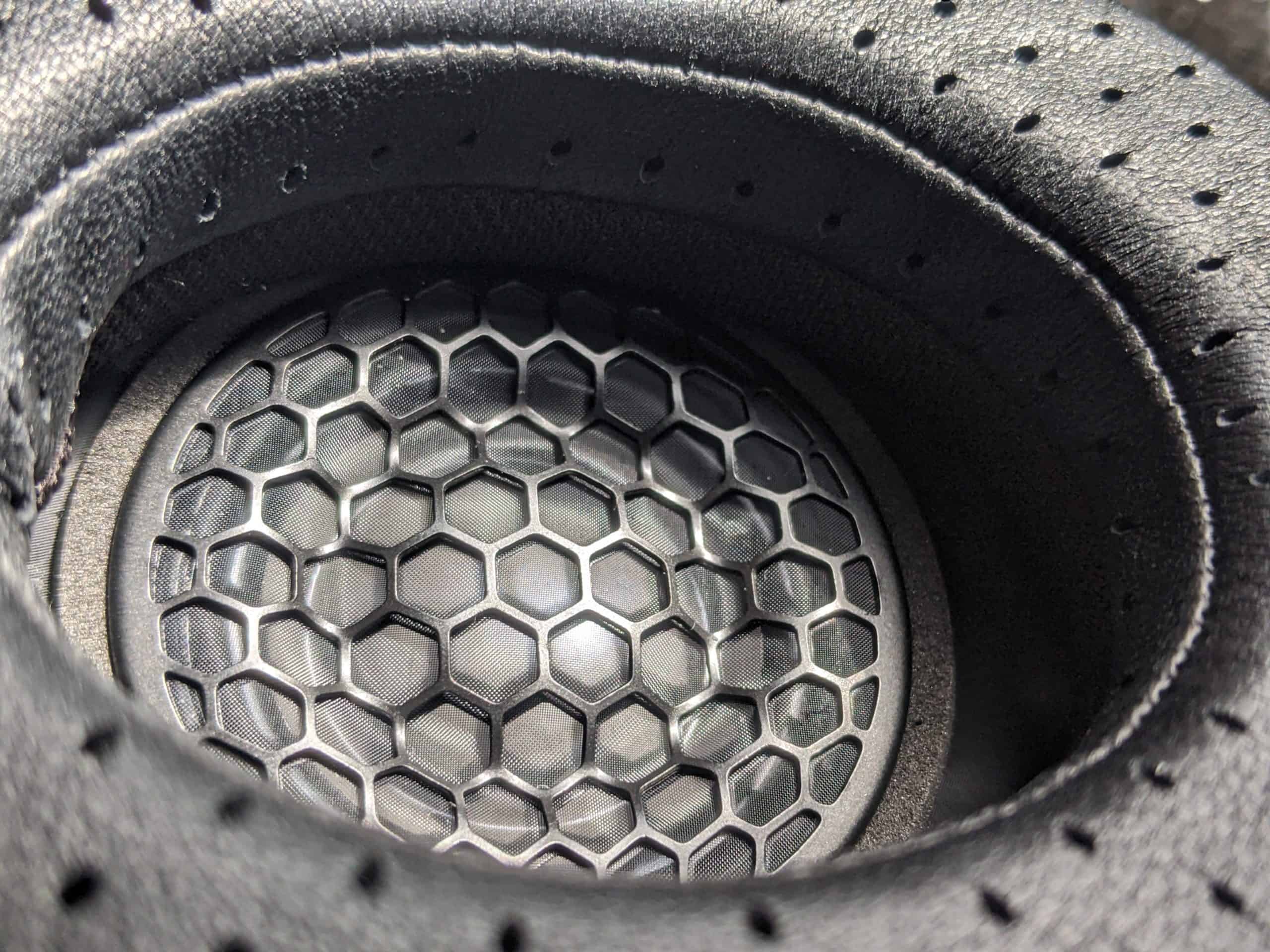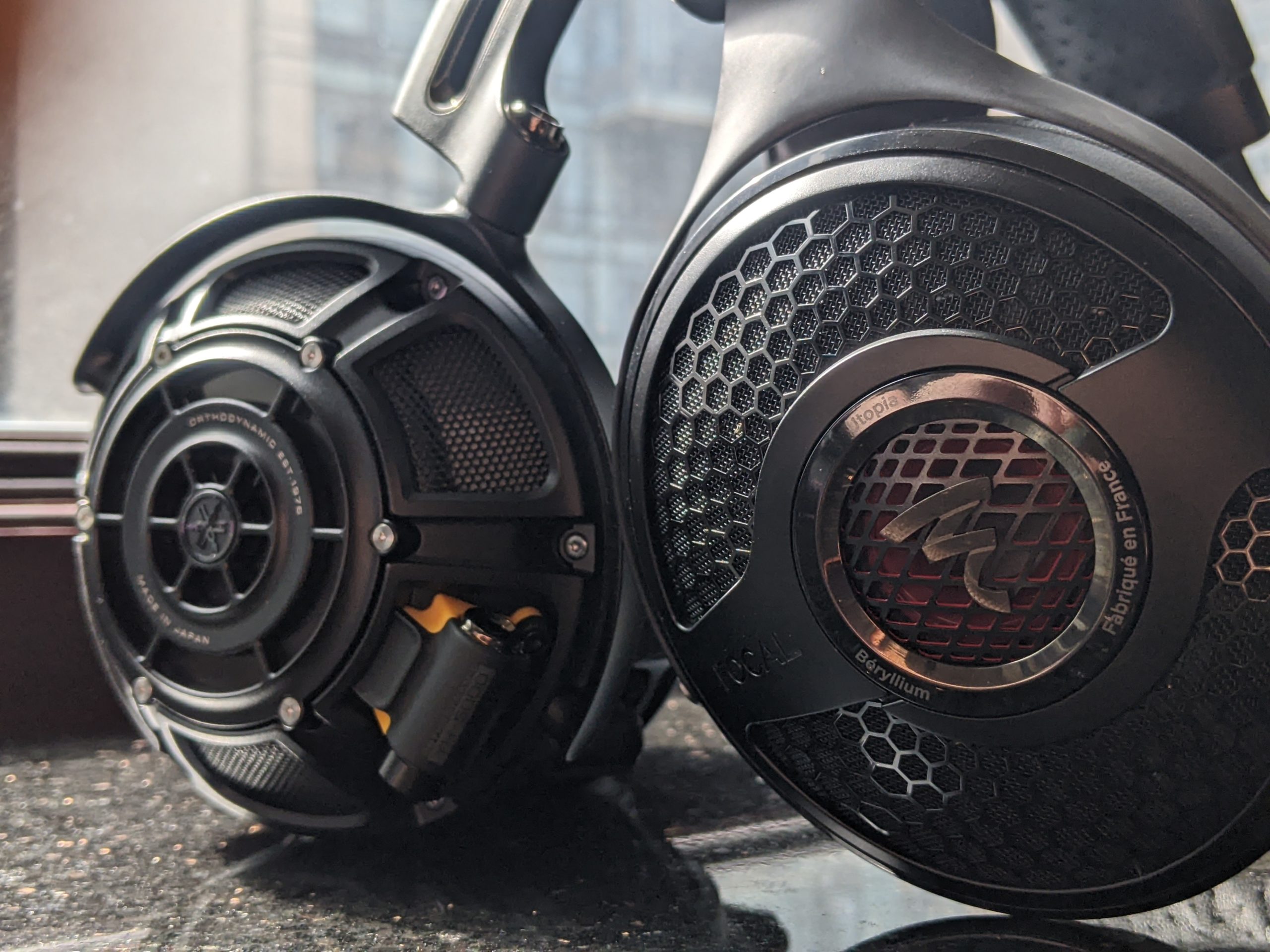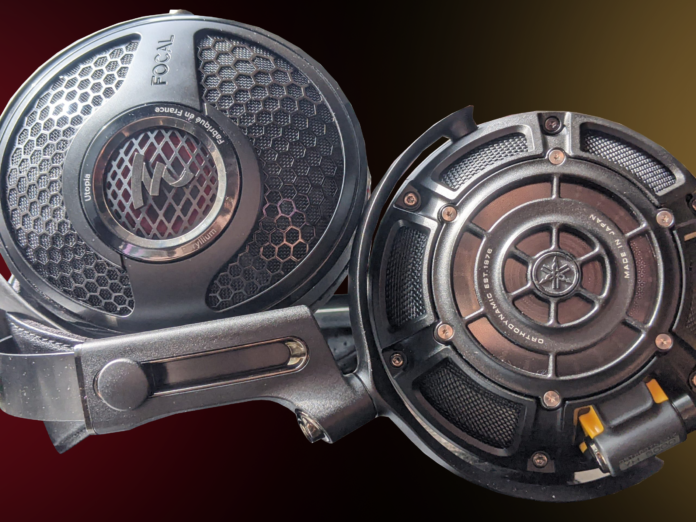Yamaha YH-5000SE vs. Focal Utopia 2022 Comparison Review
In my recent video review for the Yamaha YH-5000SE, a number of comments requested a comparison to another $5,000 headphone; yes, you know the one, the Focal Utopia 2022. It’s been my burden to bare listening with both for the past couple of days, and it’s now time to put these two heavyweights up against one another. So, if you’re lucky enough to have a $5,000 headphone budget, I hope this review gives you something to chew on. As usual, let’s peek inside their boxes, go over both units’ impressive designs, and finally, the part you’re probably here for: see how their sound profiles stack up.
What’s in The Box?
| Yamaha YH-5000SE | Focal Utopia 2022 |
|
|
Look and Feel

Perhaps the most significant difference we have to go over here is the difference in weight between the two headphones. The Focal Utopia 2022 is 490 grams: somewhat heavy, but around average weight for the ultra-high-end class of headphone in which it finds itself. The Yamaha YH-5000SE is a mere 320 grams, which is rather lightweight for a headphone in general, and exceptional in context with its peers such as the Utopia. If you find weight is far and away the main deciding factor in how comfortable you find a headphone, there’s objectively a clear winner here.
However, if you’re like most people and find weight just one important factor in considering fit and comfort, you might have a hard choice to make. I find both pairs of headphones to be amongst the most comfortable that I’ve gotten to wear, despite their enormously different fits.
Clamp Pressure: The Focal Utopia 2022 has a more secure fit, with moderate but firm clamp pressure in its headband. The YH-5000SE has a gentle clamp pressure, that when paired with its light weight, makes it an easy-and-breezy fit.
Ear Pads: The Utopia 2022 has somewhat firmer earpads than the YH-5000SE that are made out of lambskin leather and microfiber fabric. The thinner, squishier ear pads on the YH-5000SE come in two varieties: the default are leather with sheepskin on the inside ridge, or you can change them out for more dampening Ultrasuede pads. It’s also worth noting that the pads on the YH-5000SE are very easy to switch on and off due to the plastic tracks that allow them to click into position onto the cans. It seems that a listener isn’t at risk of having their ear touch up against the driver/inner grill of either headphone, but I should mention that the YH-5000SE’s pads feature a thin mesh that rests against a listener’s ears. This feature didn’t take any getting used to and I hardly noticed it.

Headbands and Adjustment Mechanisms: The YH-5000SE features a manual adjustment suspension headband made of leather with a lightly-padded Ultrasuede underside. Though this feature can sometimes be tedious on other headphones, Yamaha pulls it off. The adjustment sliders are highly resistant, allowing a listener to make precise tweaks that will stay in place even when wearing the headphone for several hours. The Utopia makes its adjustments with more typical sliding cans that click into place in small intervals. It features a well padded headband that seems to be made out of memory foam and porous lambskin.
Technical Design and Specs
The Utopia and YH-5000SE are significantly different from one another in their technical designs as well. The most general and apparent difference can be found in driver type: The Focal Utopia 2022 has a 40mm beryllium dynamic driver, while the Yamaha YH-5000SE has an orthodynamic (AKA planar) driver.

To quote Yamaha, some special technical efforts that went into the YH-5000SE’s driver include “…eliminating the fixed central structure of conventional headphone drivers, ensuring shape retention by use of concentric circle corrugation and pattern reinforcement, and avoiding magnetic substances in the vicinity.” Deep, cavernous cans provide natural acoustic volume, and a dutch weave stainless steel filter controls internal pressure, featuring an arch-shaped protrusion that serves as a reflector. Magnesium was used for the frame for its highly damping qualities, improving sonic accuracy by reducing the effects of frame vibrations.
The Utopia 2022 features an M-shaped speaker driver dome that was initially developed for the Focal Clear. This M shape closely follows the shape of the driver, which improves linearity and general accuracy. The 2022 edition sees an upgrade made to the former-less voice coil, which is now made of 70% aluminum and 30% copper for improved durability and reliability.
| Spec | Yamaha YH-5000SE | Focal Utopia 2022 |
| Driver/Operating Principle | Planar/Open Back | 40mm Beryllium Dynamic/Open Back |
| Impedance | 34 ohms | 80 ohms |
| Frequency Response | 5 Hz – 70 kHz | 5 Hz – 50 kHz |
| Sensitivity | 98 dB | 104 dB |
| Weight | 320 grams | 490 grams |
Soundstage and Imaging
Focal describes the Utopia as “loudspeakers for your head,” and I find this most apparent in its imaging and staging. The Utopia is an exceptionally open open-back headphone, allowing sound to airily dissipate around your ears and beyond – I even hear room reflections of the music I’m listening to bouncing around my listening environment and back into the headphones. When it comes to stages in headphones, as opposed to speakers, the “stage” or “image” is almost always expressed as some sort of phantom audio illusion – the sound isn’t literally six feet to your left, but it’s as if it is. The Utopia 2022 is distinct in the sense that is has a truly spatial stage that that finds genuine external expression in the space around a listener. Once I started thinking of the Utopia’s stage as a premium near-field monitor listening experience, I couldn’t shake the thought, and ultimately that’s how I would succinctly describe it. Mostly forward facing with moments of over-the shoulder reach, playing with the surrounding environment in a way that figuratively and literally establishes a sound’s position and proximity to your head. It’s an incredibly unique stage, and to date, I can’t think of anything quite like it. I don’t find this to be the sort of imaging and staging that can excitedly make your head spin; rather, it seems “proper” and well organized.
I found the stage on the Yamaha YH-5000SE to sound a little more familiar – a more refined version of stages I’ve heard on other headphones. I’m a Meze 109 Pro owner, and while it’s obvious that the YH-5000SE is several stratospheres above a very good sub-$1,000 headphone, I nonetheless think there’s a similarity found here in the style of their stages. The YH-5000SE surprised me when I first listened with it: the stage is somewhat insulated and contained close-to-the-head. This trait doesn’t betray its vivid spatial character: hard pans are consistently felt as if they originate from behind my shoulders, and left-right movements are felt as if they’re travelling over my head, or in the case of lower frequencies, under my jaw. So while the stage is tight, and isn’t open and airy like the Utopia, it’s nonetheless dynamic and precise, representing the most subtle stereo positions with a highly exposing fluidity.
Ultimately, the Focal Utopia 2022 and the Yamaha YH-5000SE yield nearly opposite appeals in their imaging and staging, but are similarly skilled. While the Utopia spreads itself out in front of my face for me to sift through a track’s various layers and components, the YH-5000SE scales things down, providing the opportunity for an up-close inspection.
Some additional notes:
-With the Utopia’s bigger stage, there are more spatial dynamics at work. Vocals frequently jump out as feeling closer to the face while the rest of the composition hangs further back. The YH-5000SE on its own performs impressively in this regard as well, but seems to be outdone here when judged against the Utopia.
-Though the Utopia may be capable of reaching greater heights in its imaging, the YH-5000SE seems more eager to engage or activate its sense of height. This is primarily felt in movement: the Utopia moves in front of my face, while the YH-5000SE moves around my head.
-The Utopia holds its appeal in a stage that feels natural, situating parts the way they might be heard on a live stage. The YH-5000SE might be more appealing to someone who wants more energy and movement rather than realism.
Lows
The Utopia has a more balanced signature than the YH-5000SE, starting with its low end. Subs are present but find less expression than they do in the YH-5000SE. After a moderate but noticeable sub bass roll off, mid bass and high bass do a lot of the low end leg work. Though there are elements of warmth going for the YH-5000SE in the mid range, I think most listeners would agree that the Utopia has a warmer signature due to it’s almost iconic high bass balance.
The YH-5000SE approaches its low end rather differently, putting more amplitude into its subs and mid bass and keeping things fairly tame in its high bass. It’s a low end energy that you might sooner feel loudly than hear loudly. Where the Utopia has a continuously lush quality linking its low end to its low mids, the Yamaha YH-5000SE creates a clean distinction between its lower and center frequencies by keeping its emphasis deeper in its bass.
A succinct comparison note is that the Utopia’s low end is punchier and fuller sounding with its high bass profile being what it is. The YH-5000SE has a bit more rumble and less punch, and its modest high bass is less persistently present during listens; instead, its a low end that jumps into action when a song is plunging deep into its bass. If there’s a trade off to be had here, the Utopia offers more in the way of pleasant fullness in its low end and low mids, while the YH-5000SE is more about clean separation between its low end and center frequencies.
Mids
Though the Utopia has a very balanced mid range, its high bass informs it in a way that gives low mids a moderate prominence. To me, the low mid energy on the Utopia is nearly indistinguishable from its high bass, and the two seem to work in tandem to produce a distinct warmth that can be heard in every single listen. However, center and high mids seem to stay mostly level with low mids, which prevents the overemphasis and softening of, for example, vocal and acoustic guitar fundamentals. The Utopia’s emergence from its warm and fuzzy high bass and low mids into its crisp and clear center and high mids seems to happen on a smooth gradient.
As one might expect at this point, the YH-5000SE handles its center frequencies a bit differently. There’s more high mid drive present, making snare drums crack a little more than they thump, and giving electric guitars and vocals a more driving and lightweight presentation than what’s heard in the Utopia. The Utopia’s low end and mids are more consistently even with one another, while the Yamaha’s mids, particularly high mids, seem a bit more prominent and driving in its balance.
Highs
Though the Focal Utopia 2022 and the Yamaha YH-5000SE find differences all through out their balance, I hear their contrasting qualities take their most noticeable form in their treble profiles. The Utopia is an endlessly smooth headphone, and this applies to its treble as well. Though its high frequency amplitude isn’t at all what I would call recessed or darkened, I might call it cautious. Listening with the Utopia, I was completely safe from moments of pain or peaky-ness. Much like the rest of its tuning, its high end balance serves to impart a pleasant realism that lifts some of the density we find earlier in its balance. Ultimately, I don’t find the Utopia’s high end to be a defining characteristic for the headphone; rather, it finds its character in its high bass and low mids and uses its treble profile as a supporting characteristic.
The YH-5000SE takes a bolder approach to its treble – specifically its low and mid treble. Electric guitars are ripe with sharp and shiny harmonic qualities. The high ends of reverbs and the overtones in vocals are more prominent than what’s heard on the Utopia. Where the Utopia is using its high end for a supporting role in maintaining realism, the YH-5000SE has a more colorful and boosted high end that gives the headphone some additional distinct character. It takes a risk with pain that, to my ears, pays off with intensity and detail.
Overall

Look: you’re not going to wrong getting either the Focal Utopia 2022 or Yamaha YH-5000SE. Both headphones provide a level of detail and sensitivity that is a constant testament to their $5000 price tags. However, the two are nonetheless very different from another and suit very different subjective preferences. I’ll try my best to sum this up with the following generalization: the Utopia offers more in the way of warmth, neutral balance, general pleasantness, and a realistic soundstage. The YH-5000SE is better suited for people who like hearing some extremes in their balances, highs and low alike, and a more eager and active sound stage.
What, you wanted a decisive victor? While my own subjective preferences have me reaching for the YH-5000SE every chance that I get, I couldn’t in my right mind call it a “better” headphone. It’s simply more geared towards my preferences, as the Utopia will be for others.
The Focal Utopia 2022 can be ordered here, the Yamaha YH-5000SE can be ordered here from Audio46.
| Yamaha YH-5000SE | Focal Utopia 2022 |
|
|
Compare the ranking of various headphones, earbuds and in-ear monitors using our tools.
Discuss this, and much more, over on our forum.
---MAJORHIFI may receive commissions from retail offers.















